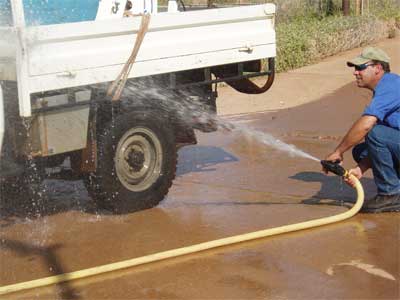Western Australia
April 15, 2008
One of the worst environmental
weeds in Australia, not seen before in Western Australia, has
been stopped in its tracks and controlled in the Kimberley by
Department of Agriculture
and Food Biosecurity officers.
Parthenium (Parthenium hysterophorus) can grow up to two
metres high and produce up to 100,000 seeds per plant. It costs
Queensland more than $22 million a year in reduced production
and increased management costs.
The Kimberley manager for the Department of Agriculture and Food
Noel Wilson said parthenium plants had been discovered growing
by a quarantine washdown bay in Kununurra during routine
surveillance carried out in this area.
|
 |
“Our washdown bays are there to minimise the chance of weed
seeds entering Western Australia that could threaten our
agricultural and pastoral industries,” Mr Wilson said.
“The seeds of this weed have been captured in a washdown of a
vehicle coming across the border, and they germinated within our
quarantine facility,” Mr Wilson said.
“It is a real win for DAFWA’s biosecurity efforts, and it
indicates the important role washdown facilities play in
protecting Western Australia’s agricultural and pastoral
industries,” he said.
Parthenium weed affects the viability of primary production
including live stock and grain enterprises. It can also cause
health problems for humans and animals.
“It is toxic to stock, and people can have allergic reactions to
its pollen, causing dermatitis, hay fever and asthma,” Mr Wilson
said.
“It is a particularly bad environmental weed and its seeds adapt
very well to semi-arid environments such as the Kimberley
environment. The seeds can germinate, grow, mature and set in
four weeks,” he said.
“Once this type of invasive weed establishes, it is very hard to
control its spread. Without our biosecurity efforts, these
parthenium seeds could have spread further afield to where-ever
the vehicles were going,” Mr Wilson said.
 Parthenium is a registered as one of the twenty Weeds of
National Significance because of its invasive nature, potential
for spread, and economic and environmental impacts. Parthenium is a registered as one of the twenty Weeds of
National Significance because of its invasive nature, potential
for spread, and economic and environmental impacts.
The weed is native to the subtropics of North and South America.
Its leaves are pale green, branched and covered with soft fine
hairs.
It has small white flowers with five distinct corners. Each
flower produces several black wedge-shaped seeds that are 2mm
long with thin white scales.
“DAFWA urges local residents and travelers in the Kimberley to
pay close attention to property and vehicle hygiene (photo). The seeds
of invasive weeds can spread very easily by vehicles, machinery,
stock, grain and fodder,” Mr Wilson said.
Further information about Parthenium weed is available from
DAFWA offices in
the Kimberley or by calling 1800 084 881.
Information on all Weeds of National Significance and on the
Alert List species is available at
http://www.weeds.crc.org.au/publications/weed_man_guides.html
|
|